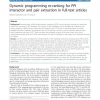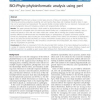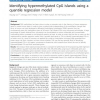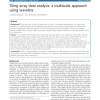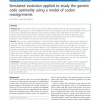BMCBI
2011
13 years 6 months ago
2011
Background: The OMIM database is a tool used daily by geneticists. Syndrome pages include a Clinical Synopsis section containing a list of known phenotypes comprising a clinical s...
BMCBI
2011
13 years 6 months ago
2011
Background: Metal-containing proteins comprise a diverse and sizable category within the proteomes of organisms, ranging from proteins that use metals to catalyze reactions to pro...
BMCBI
2011
13 years 6 months ago
2011
Background: Phylogenetic trees are an important tool for representing evolutionary relationships among organisms. In a phylogram or chronogram, the ordering of taxa is not conside...
BMCBI
2011
13 years 6 months ago
2011
Background: Experimentally verified protein-protein interactions (PPIs) cannot be easily retrieved by researchers unless they are stored in PPI databases. The curation of such dat...
BMCBI
2011
13 years 6 months ago
2011
Background: Phyloinformatic analyses involve large amounts of data and metadata of complex structure. Collecting, processing, analyzing, visualizing and summarizing these data and...
BMCBI
2011
13 years 6 months ago
2011
Background: Multiclass classification of microarray data samples with a reduced number of genes is a rich and challenging problem in Bioinformatics research. The problem gets hard...
BMCBI
2011
13 years 6 months ago
2011
Background: DNA methylation has been shown to play an important role in the silencing of tumor suppressor genes in various tumor types. In order to have a system-wide understandin...
BMCBI
2011
13 years 6 months ago
2011
Background: Alternative splicing (AS) is a process which generates several distinct mRNA isoforms from the same gene by splicing different portions out of the precursor transcript...
BMCBI
2011
13 years 6 months ago
2011
Background: Tiling array data is hard to interpret due to noise. The wavelet transformation is a widely used technique in signal processing for elucidating the true signal from no...
BMCBI
2011
13 years 6 months ago
2011
Background: As the canonical code is not universal, different theories about its origin and organization have appeared. The optimization or level of adaptation of the canonical ge...

